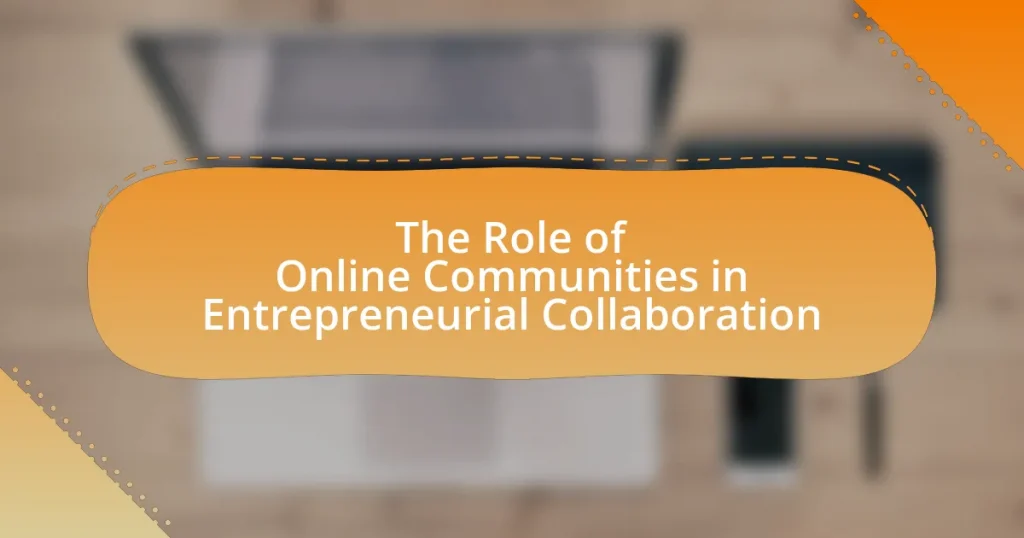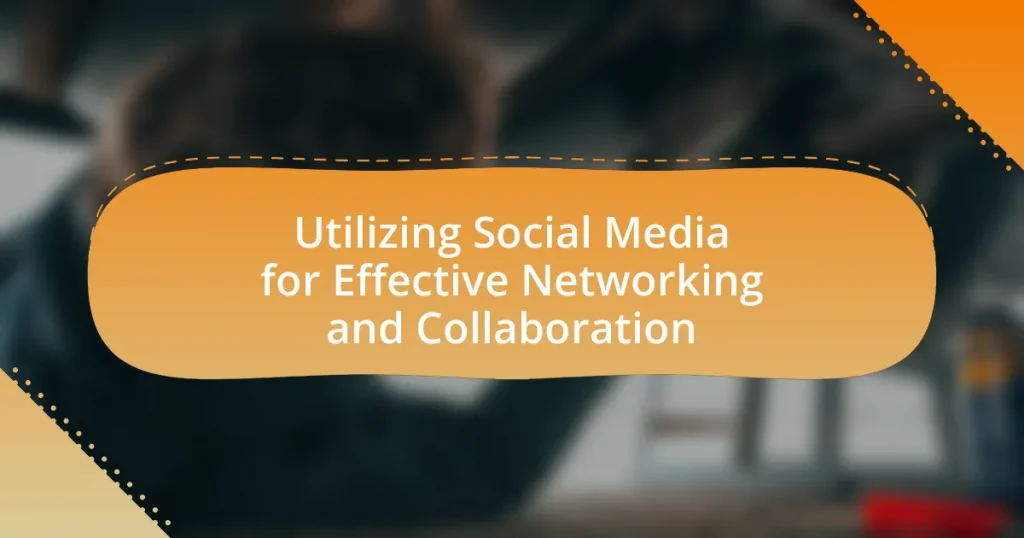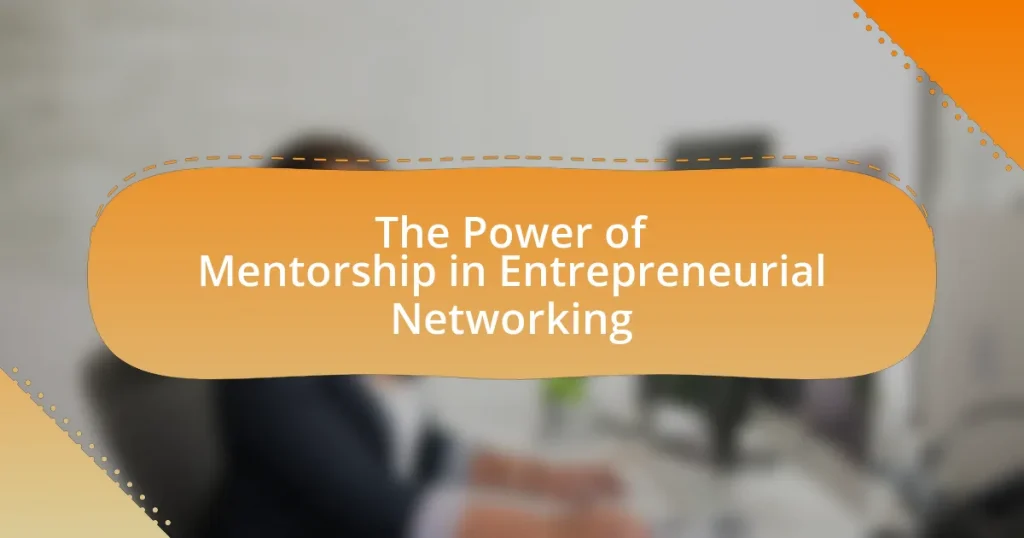Brainstorming techniques are structured methods essential for generating creative ideas and solutions in entrepreneurship. This article explores various brainstorming methods, including mind mapping, free writing, and the nominal group technique, highlighting their importance in enhancing problem-solving, stimulating creativity, and fostering teamwork. It discusses how these techniques can lead to a significant increase in idea generation, the principles behind effective brainstorming, and the differences between brainstorming and traditional problem-solving methods. Additionally, the article outlines best practices for conducting brainstorming sessions, the role of diverse perspectives, and practical tips for maximizing outcomes, ultimately emphasizing the critical role of brainstorming in overcoming entrepreneurial challenges and driving innovation.
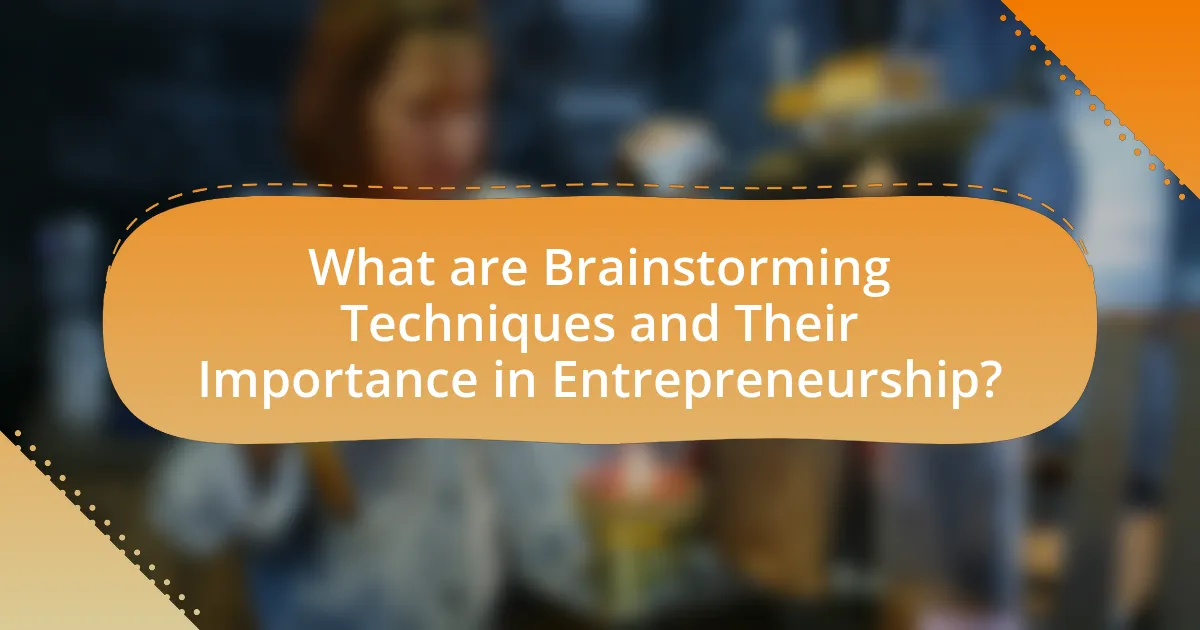
What are Brainstorming Techniques and Their Importance in Entrepreneurship?
Brainstorming techniques are structured methods used to generate creative ideas and solutions, crucial for entrepreneurship. These techniques, such as mind mapping, free writing, and the nominal group technique, facilitate collaboration and encourage diverse perspectives, leading to innovative business concepts. The importance of these techniques in entrepreneurship lies in their ability to enhance problem-solving, stimulate creativity, and foster teamwork, which are essential for developing viable business strategies. Research indicates that companies employing brainstorming techniques experience a 20% increase in idea generation, demonstrating their effectiveness in driving entrepreneurial success.
How do brainstorming techniques facilitate idea generation?
Brainstorming techniques facilitate idea generation by creating an open environment that encourages free thinking and collaboration among participants. These techniques, such as mind mapping and round-robin brainstorming, promote the sharing of diverse perspectives, which can lead to innovative solutions. Research indicates that groups engaged in brainstorming can produce 20% more ideas than individuals working alone, highlighting the effectiveness of collective creativity. Additionally, structured brainstorming sessions can help overcome mental blocks, allowing participants to build on each other’s ideas, thereby enhancing the overall quality and quantity of generated concepts.
What are the key principles behind effective brainstorming?
The key principles behind effective brainstorming include encouraging open communication, deferring judgment, fostering a collaborative environment, and promoting quantity over quality of ideas. Open communication allows participants to freely share thoughts without fear of criticism, which enhances creativity. Deferring judgment ensures that all ideas are considered before evaluating their feasibility, leading to a broader range of possibilities. A collaborative environment encourages diverse perspectives, which can lead to innovative solutions. Finally, prioritizing quantity over quality during the initial stages helps generate a wealth of ideas, from which the best can be refined later. These principles are supported by research indicating that groups that embrace these practices tend to produce more creative and effective outcomes.
How do brainstorming techniques differ from traditional problem-solving methods?
Brainstorming techniques differ from traditional problem-solving methods primarily in their approach to idea generation and collaboration. While traditional problem-solving often follows a linear, analytical process that emphasizes critical thinking and evaluation of existing solutions, brainstorming encourages free-flowing creativity and the generation of numerous ideas without immediate judgment. This divergence allows for a broader range of possibilities, fostering innovation and out-of-the-box thinking, which is essential for entrepreneurial endeavors. Research indicates that brainstorming can lead to more diverse and original ideas, as it promotes a non-hierarchical environment where all participants feel empowered to contribute, contrasting with the structured and often restrictive nature of traditional methods.
Why is brainstorming essential for entrepreneurs?
Brainstorming is essential for entrepreneurs because it fosters creativity and generates innovative ideas crucial for business development. This collaborative process allows entrepreneurs to explore diverse perspectives, leading to unique solutions and strategies that can differentiate their ventures in competitive markets. Research indicates that brainstorming sessions can increase idea generation by up to 20% compared to individual efforts, highlighting its effectiveness in enhancing creativity and problem-solving capabilities.
How does brainstorming contribute to innovation in business?
Brainstorming contributes to innovation in business by fostering a collaborative environment that encourages the generation of diverse ideas. This technique allows team members to freely share their thoughts, leading to a wider range of potential solutions and creative approaches. Research indicates that organizations employing brainstorming sessions can enhance problem-solving capabilities, as evidenced by a study published in the Journal of Business Research, which found that teams that engage in brainstorming produce more innovative outcomes compared to those that do not. By leveraging collective intelligence, brainstorming not only stimulates creativity but also accelerates the development of new products and services, ultimately driving business growth and competitive advantage.
What role does brainstorming play in overcoming entrepreneurial challenges?
Brainstorming plays a crucial role in overcoming entrepreneurial challenges by fostering creativity and generating diverse solutions. This collaborative process encourages participants to share ideas freely, which can lead to innovative approaches for addressing obstacles such as market competition, resource limitations, or operational inefficiencies. Research indicates that brainstorming sessions can enhance problem-solving capabilities, as they leverage the collective intelligence of a group, resulting in a broader range of potential solutions. For instance, a study published in the Journal of Business Research found that teams engaged in brainstorming produced more creative outcomes compared to individuals working alone, highlighting the effectiveness of this technique in navigating entrepreneurial difficulties.

What are the Different Types of Brainstorming Techniques?
There are several types of brainstorming techniques, including traditional brainstorming, mind mapping, brainwriting, and reverse brainstorming. Traditional brainstorming involves group discussions where participants freely share ideas without criticism, fostering creativity. Mind mapping visually organizes thoughts and ideas, allowing connections between concepts to be easily identified. Brainwriting encourages individuals to write down their ideas independently before sharing them, which can lead to a broader range of suggestions. Reverse brainstorming focuses on identifying potential problems or obstacles, prompting participants to think critically about solutions. Each technique serves different purposes and can be effective in generating entrepreneurial ideas.
How can mind mapping enhance brainstorming sessions?
Mind mapping enhances brainstorming sessions by visually organizing thoughts and ideas, which facilitates clearer connections and relationships among concepts. This visual representation allows participants to see the big picture and encourages free-flowing creativity, as it breaks down complex ideas into manageable parts. Research indicates that using mind maps can increase retention and recall of information by up to 10% compared to linear note-taking methods, as shown in a study published in the Journal of Educational Psychology. This improved cognitive engagement leads to more innovative solutions and a greater volume of ideas generated during brainstorming sessions.
What are the steps to create an effective mind map?
To create an effective mind map, start by identifying the central idea or topic you want to explore. Next, branch out from the central idea by adding related subtopics or categories, using lines to connect them visually. Then, for each subtopic, include keywords, images, or short phrases that represent ideas or concepts associated with that subtopic. Ensure that the layout is clear and organized, allowing for easy navigation and understanding. Finally, review and refine the mind map by adding or removing elements to enhance clarity and relevance. This structured approach facilitates better idea generation and organization, as supported by research indicating that visual mapping enhances memory retention and creativity.
How does mind mapping help in organizing thoughts and ideas?
Mind mapping helps in organizing thoughts and ideas by visually structuring information, which enhances comprehension and retention. This technique allows individuals to break down complex concepts into simpler, interconnected components, facilitating clearer understanding. Research indicates that visual aids, such as mind maps, can improve memory recall by up to 30% compared to linear note-taking methods. By using a central idea and branching out into related topics, mind mapping encourages a holistic view of the subject matter, making it easier to identify relationships and prioritize information effectively.
What is the role of group brainstorming in entrepreneurship?
Group brainstorming plays a crucial role in entrepreneurship by fostering collaboration and generating diverse ideas. This collective approach allows entrepreneurs to leverage the varied perspectives and expertise of team members, leading to innovative solutions and strategies. Research indicates that group brainstorming can enhance creativity, as individuals build on each other’s thoughts, resulting in a greater quantity and quality of ideas compared to solitary brainstorming. For instance, a study published in the Journal of Business Venturing found that teams engaged in brainstorming sessions produced 20% more viable business concepts than individuals working alone. This demonstrates that group brainstorming not only stimulates creativity but also increases the likelihood of successful entrepreneurial outcomes.
How can diverse perspectives improve the brainstorming process?
Diverse perspectives enhance the brainstorming process by introducing a wider range of ideas and solutions. When individuals from different backgrounds, experiences, and disciplines collaborate, they contribute unique viewpoints that can challenge conventional thinking and stimulate creativity. Research indicates that teams with diverse members are more innovative; for instance, a study published in the Harvard Business Review found that diverse teams are 35% more likely to outperform their homogeneous counterparts in terms of creativity and problem-solving. This variety in thought processes leads to more comprehensive discussions, ultimately resulting in more effective and innovative outcomes during brainstorming sessions.
What are the best practices for conducting group brainstorming sessions?
The best practices for conducting group brainstorming sessions include setting clear objectives, encouraging open communication, and fostering a non-judgmental environment. Clear objectives guide participants on the focus of the session, ensuring that discussions remain relevant and productive. Open communication allows all members to share ideas freely, which enhances creativity and collaboration. A non-judgmental environment encourages participants to express unconventional ideas without fear of criticism, which is crucial for generating innovative solutions. Research indicates that diverse groups produce more creative outcomes, as seen in studies by the American Psychological Association, which highlight the benefits of varied perspectives in brainstorming sessions.
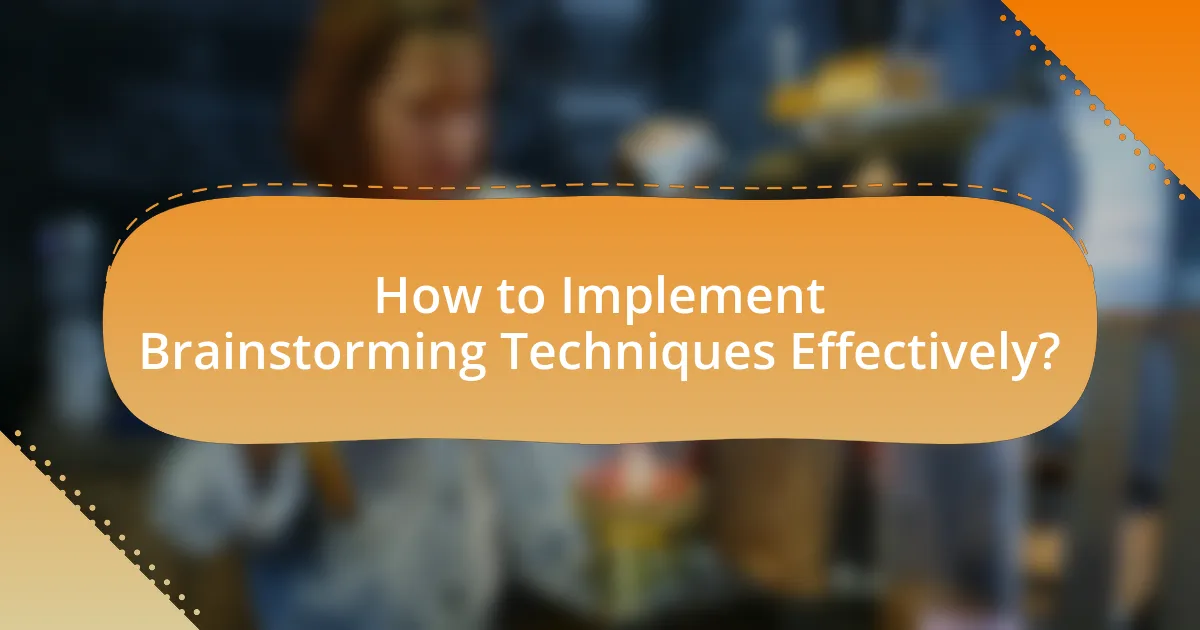
How to Implement Brainstorming Techniques Effectively?
To implement brainstorming techniques effectively, establish a clear objective for the session. This focus ensures that participants generate relevant ideas aligned with the entrepreneurial goals. Research indicates that structured brainstorming sessions, such as using the “Round Robin” method, can enhance participation and idea diversity, leading to more innovative solutions. Additionally, setting a time limit encourages quick thinking and prevents over-analysis, which can stifle creativity. According to a study published in the Journal of Business Research, teams that utilize specific brainstorming techniques, like mind mapping, produce 20% more ideas than those that do not.
What are the steps to prepare for a successful brainstorming session?
To prepare for a successful brainstorming session, follow these steps: define a clear objective, gather the right participants, create a conducive environment, establish ground rules, and provide necessary materials. Defining a clear objective ensures that the session remains focused and productive, while selecting participants with diverse perspectives fosters creativity. A conducive environment, such as a comfortable space with minimal distractions, enhances engagement. Establishing ground rules, like encouraging open-mindedness and deferring judgment, promotes a safe atmosphere for idea sharing. Lastly, providing necessary materials, such as whiteboards or sticky notes, facilitates the organization and visualization of ideas. These steps are supported by research indicating that structured brainstorming sessions yield higher quality ideas and greater participant satisfaction.
How do you set the right environment for brainstorming?
To set the right environment for brainstorming, create a space that is open, comfortable, and free from distractions. This involves arranging seating in a circular or semi-circular layout to promote inclusivity and engagement, ensuring adequate lighting to enhance focus, and providing necessary materials such as whiteboards or sticky notes for idea generation. Research indicates that a relaxed atmosphere can increase creativity; for instance, a study published in the Journal of Creative Behavior found that informal settings can lead to a 20% increase in idea generation compared to formal environments.
What tools and resources can enhance the brainstorming experience?
Digital collaboration tools such as Miro, Trello, and Google Workspace can significantly enhance the brainstorming experience. Miro offers an interactive whiteboard platform that allows teams to visualize ideas in real-time, facilitating creativity and collaboration. Trello provides a structured way to organize thoughts and tasks, enabling participants to prioritize and track ideas effectively. Google Workspace integrates various applications like Docs and Sheets, allowing for seamless sharing and editing of brainstorming notes. Research indicates that using collaborative tools can increase engagement and productivity in group settings, leading to more innovative outcomes.
How can you evaluate and refine ideas generated from brainstorming?
To evaluate and refine ideas generated from brainstorming, categorize the ideas based on criteria such as feasibility, impact, and alignment with goals. This structured approach allows for a systematic assessment of each idea’s potential. Following categorization, prioritize the ideas by scoring them against the established criteria, which helps in identifying the most promising concepts. Research indicates that using a scoring system can enhance decision-making efficiency, as seen in a study by the Harvard Business Review, which highlights that structured evaluation processes lead to better outcomes in innovation. Finally, gather feedback from stakeholders to further refine the selected ideas, ensuring they meet the needs of the target audience and market demands.
What criteria should be used to assess the viability of ideas?
To assess the viability of ideas, criteria such as market demand, feasibility, scalability, and profitability should be used. Market demand evaluates whether there is a sufficient audience or need for the idea, supported by data indicating consumer interest or trends. Feasibility examines the practicality of implementing the idea, including resource availability and technical requirements. Scalability assesses the potential for growth and expansion, determining if the idea can adapt to increasing demand. Profitability analyzes the financial aspects, ensuring that the idea can generate revenue that exceeds costs. These criteria are essential for making informed decisions about pursuing entrepreneurial ideas.
How can feedback be effectively integrated into the idea refinement process?
Feedback can be effectively integrated into the idea refinement process by systematically collecting, analyzing, and applying insights from stakeholders. This approach ensures that diverse perspectives are considered, enhancing the quality of the ideas. For instance, utilizing structured feedback mechanisms such as surveys or focus groups allows for targeted input, which can be quantitatively assessed to identify common themes or areas for improvement. Research indicates that incorporating feedback loops can increase the likelihood of successful innovation by up to 30%, as it aligns the development process with user needs and market demands.
What are some practical tips for maximizing brainstorming outcomes?
To maximize brainstorming outcomes, establish clear objectives and encourage open participation. Setting specific goals helps focus the session, while fostering an inclusive environment allows diverse ideas to emerge. Research indicates that diverse teams generate more innovative solutions; a study by the Harvard Business Review found that diverse groups outperform homogeneous ones in problem-solving. Additionally, using techniques like mind mapping or the “six thinking hats” method can enhance creativity and organization during the session. These strategies not only stimulate idea generation but also facilitate better evaluation of concepts, leading to more effective outcomes.
How can you encourage participation and creativity among team members?
To encourage participation and creativity among team members, implement structured brainstorming sessions that promote open dialogue and idea sharing. Research shows that diverse teams generate more innovative solutions, as highlighted in a study by the Harvard Business Review, which found that teams with varied backgrounds produce 19% more ideas than homogeneous groups. Establishing a safe environment where all contributions are valued fosters a culture of creativity, leading to increased engagement and collaboration. Additionally, utilizing techniques such as mind mapping and role-playing can stimulate creative thinking and enhance participation, as they allow team members to explore ideas from different perspectives.
What common pitfalls should be avoided during brainstorming sessions?
Common pitfalls to avoid during brainstorming sessions include allowing criticism of ideas, dominating the conversation, and failing to establish clear objectives. Allowing criticism stifles creativity, as participants may hesitate to share unconventional thoughts due to fear of judgment. Dominating the conversation can lead to a lack of diverse input, as quieter members may feel marginalized and less likely to contribute. Failing to establish clear objectives can result in unfocused discussions, making it difficult to generate actionable ideas. Research indicates that structured brainstorming sessions, which set guidelines and encourage equal participation, yield more innovative outcomes.

